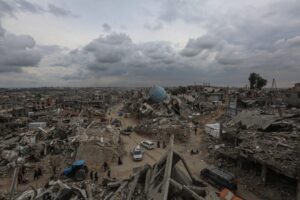Gaza ceasefire is reaching a dangerous crossroads as first phase nears an end

Palestinians struggle to survive among the rubble of buildings destroyed by Israeli attacks in Beit Lahia, Gaza on 19 February 2025.
Qassam Muaddi writes in Mondoweiss on 19 February 2025:
In two weeks, on March 1, the first phase of the Gaza ceasefire will expire. By now, negotiations on phase 2 of a ceasefire should have been well under way, but that has not yet materialized. With each passing day it becomes clear that Israel is making other plans – plans that suggest a desire to return back to the bombardment of Gaza and a continuation of the more than 15-month long genocide that was paused in January.
Recent events have cast more doubt on the prospects of a lasting ceasefire and have raised questions not just about Israel’s intentions and calculations but also about the influence of the U.S. and Trump and, ultimately, how Hamas will respond.
Here’s what you need to know, and what you may expect to see in the coming weeks.
The latest: stalling and strong-arming
The Israeli army approved new “offense and defense” war plans in Gaza following concerns expressed by Israeli officials that the ceasefire in Gaza would “gradually collapse,” Israeli news site Walla reported on Wednesday.
Israeli media quoted military sources claiming that Hamas was also making preparations for a potential return to war, assessing the Israeli army’s moves, repairing its infrastructure, and recruiting new fighters.
Last week, Israel and Hamas seemed to have reached a dead end after Israel continuously violated the terms of the ceasefire’s humanitarian agreements. Hamas announced the suspension of the release of Israeli captives until Israel allowed in tents, prefabricated mobile homes, reconstruction material, and heavy machinery for the removal of rubble into Gaza.
But that week’s exchange of captives proceeded as planned last Saturday following guarantees from mediators that the aid would enter. Eventually, some of the material began to pass through the Egyptian side of the border and arrive at the Israeli side for security checks. According to Egyptian news reports, the mobile homes are capable of housing up to six people and are composed of two prefabricated rooms of vinyl-covered drywall, a small kitchenette, and a toilet. According to the ceasefire deal’s humanitarian protocol, Israel committed to allowing the entry of 60,000 prefabricated housing units and 200,000 tents. Although hundreds of these mobile houses have been waiting at the Egyptian side of the border for days, Israel hasn’t allowed their entry into the Strip.
